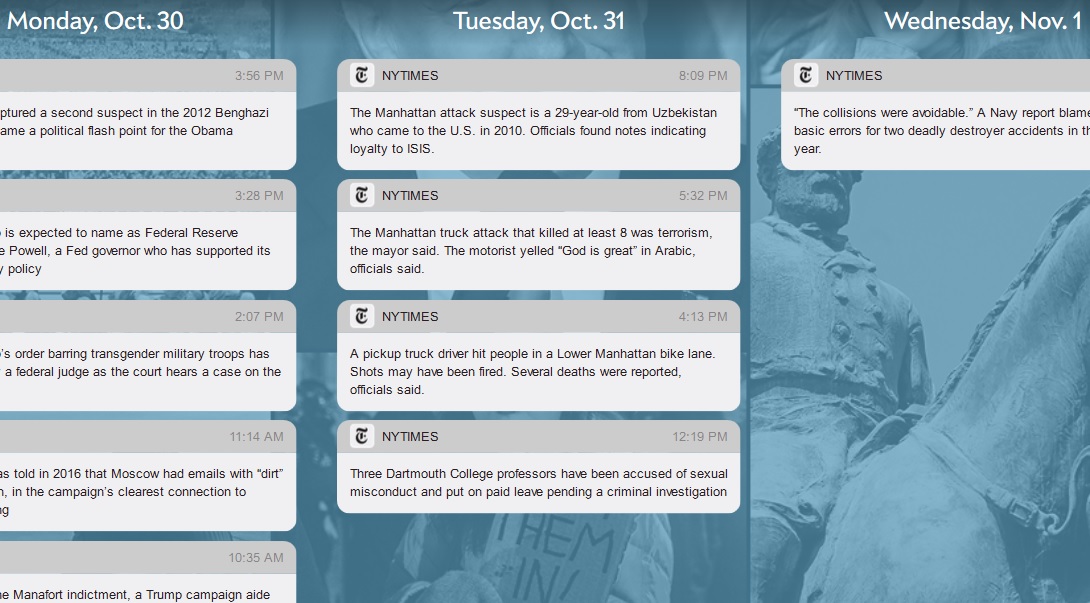The latest news often arrives to digital devices via a thought bubble. Push alerts provide audiences with short bursts of the day’s developments. Our guests from Slate put together A Year In Push Alerts: How Breaking News Became Our Lives. They detail what they found reviewing a year’s worth of push notifications from The New York Times, and they talk about a new normal where breaking news is our expectation every day.
Do you allow push alerts to your phone, or did you turn them off? When do you open up an alert to read the whole story? Post on the Ideas Network Facebook page, email ideas@wpr.org, or tweet @wprmornings. You can call 800-642-1234 during the show to share your perspective on the air.
Featured in this Show
-
Push Notifications Fuel Culture Of Breaking News
It’s not new, but some argue that breaking news — fueled by Twitter, push alerts and cable news — is more pervasive than ever before.
“I think a lot of people on both sides of the aisle have felt overwhelmed by breaking news but not been able to stop engaging,” said Allison Benedikt, executive editor at Slate.
The internet publication illustrated this concept earlier this month with an interactive graphic showing the year in push alerts — those little news bubbles that pop up on your smartphone.
The graphic shows a constant stream of alerts from the New York Times, beginning Wednesday, Nov. 9, 2016: “Donald Trump has been elected president of the United States.” Ding.
Followed by at least six more alerts that same day.
Ding. Ding. Ding. Ding. Ding. Ding.
Benedikt said push alerts make sense editorially. Major publishers, such as the New York Times and the Washington Post, feel they are a way to control their content. But it also hypes up competitiveness between news organizations.
She said sometimes one paper will be in an editorial meeting, deciding how to push a story, when they receive a push alert from their competitor. That heightens the need to get the story out, sometimes before all the details are solid.
Reporters have even started to break stories on Twitter.
Slate’s graphic has filters. Filter out all Trump-related alerts, and you’ll find notifications were decidedly quieter.
Laura Bennett, a writer and features director for Slate, attributes that to Trump’s leadership style. At the beginning of the year, any policy-related tweet from Trump was enough to elicit a breaking news alert for some outlets.
“He’s a president who excels particularly at kind of reorienting our attention on a dime,” Bennett said. “So with every kind of utterance or tweet or whatever he is sort of strategically, it seems, redirecting our attention, restarting the news cycle.”
She says as news outlets have become conscious of “alert fatigue,” they’ve slowed the pace of push alerts.
Benedikt says it’s not just the alerts that are causing news fatigue. She said before Slate’s piece on breaking news, she hadn’t even thought about turning push alerts off. She’s not convinced it would be much help.
And she doesn’t want to stop paying attention.
“Sure, I could turn off my alerts. But that wouldn’t mean I wouldn’t be sort of always checking to see what the latest news is. Or always assuming something’s about to break,” she said. “That comes for me also from Twitter, that comes from cable news, that comes from the regular internet and Facebook. It’s everywhere.”
Bennett agrees. News follows her to dinner parties and the grocery store.
“It’s just hard to avoid chatter about the news in the sense that it’s coming at you from all angles,” she said. “Because we’re living in such an outrageous political and news climate.”
Episode Credits
- Kate Archer Kent Host
- Kealey Bultena Producer
- Allison Benedikt Guest
- Laura Bennett Guest
Wisconsin Public Radio, © Copyright 2024, Board of Regents of the University of Wisconsin System and Wisconsin Educational Communications Board.



